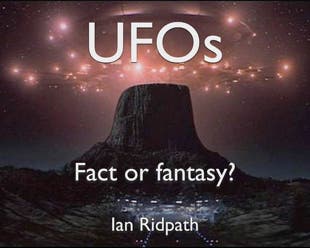
Ian Ridpath’s UFO skeptic pages
It is a capital mistake to theorize before one has data.
Insensibly one begins to twist facts to suit theories,
instead of theories to suit facts.
Sherlock Holmes, via Sir Arthur Conan Doyle
What’s on
these pages
- An article of mine on the astronomical causes of UFOs.
- An extensive summary of my investigation of the Rendlesham Forest UFO case of 1980, widely touted as one of the most significant ever to occur.
- A look back at the famous ‘flying cross’ UFO observed by two Devon policemen in 1967 (and several similar sightings in the same month).
- My explanation of a Spanish ‘close encounter’ caused by a misidentification of Venus.
- An article on SETI,
A Signalling Strategy for Interstellar Communication, based on a paper of mine originally published in the Journal of the British Interplanetary Society.
See also:
- An article of mine outlining some of the many fallacies in the so-called Sirius Mystery (PDF).
- My interview with J. Allen Hynek published in New Scientist 1973 May 17.
- My interview with Carl Sagan published in New Scientist 1974 July 4.
- Flying saucers thirty years on – my view of where the UFO field stood after a generation of research, published in New Scientist 1977 July 14. It still hasn’t moved on since then!
THERE is no doubt UFOs exist in the sense that people genuinely see things in the sky that they cannot identify. But the real question is: what do these things turn out to be on investigation?
Not all reported UFOs can be extraterrestrial spacecraft, and no one pretends they are. Even UFO believers agree that at least nine reports out of every ten are readily explicable in known terms. The main culprits are bright stars and planets, aircraft, meteors, and satellites – although a complete list of misidentifications would be almost endless. UFO proponents often point to the residue of unexplained cases as proof that there must be something to UFOs after all, but that’s not so. An unsolved case is not evidence for any theory. If even the most credible and honest witnesses turn out to be demonstrably wrong nine times out of ten it is not unreasonable to suppose that all cases would be soluble if we had sufficient information.
A cornerstone of the UFO believers’ case is that UFOs are reported by trained observers such as pilots and policemen whose eye-witness testimony would readily be accepted in a court of law. However, experience shows that they make the same mistakes as everyone else. (For some illuminating examples from the UK, see here and here.)
J. Allen Hynek, the pro-UFO astronomer who coined the famous term Close Encounters of the Third Kind, wrote in his book The Hynek UFO Report (p. 271 of the paperback edition) that ‘commercial and military pilots appear to make relatively poor witnesses’. Hynek found that the majority of pilot misidentifications were of astronomical objects, just as they are for other UFO witnesses. Only slightly better results were found by Hynek’s colleague Allan Hendry, who was chief investigator for Center for UFO Studies in the US during the 1970s. Hendry investigated more than 1,300 cases reported to the Center over the course of a year. Hendry found that he could explain 75% of the sightings from pilots. In the case of sightings by police officers, the clear-up rate rose to 94%.
Another favourite claim is that the unidentified sightings are somehow qualitatively different from the ones that are identified, but again Hendry’s experience offers little comfort. Reporting on his findings in The UFO Handbook (1979), Hendry pondered (p. 284): ‘How can I be sure if my remaining “UFOs” aren’t simply IFOs [i.e. identifieds] misperceived to the point of fantasy?’
There is an effect at work here which I term the UFO Uncertainty Principle: it states that one cannot have a UFO sighting which is both highly reliable and highly specific. By a reliable sighting I mean one with many independent witnesses who all agree on what they have seen. When these occur the object is usually something unspecific like a light in the sky and quickly becomes identified as a natural or man-made object. By specific sightings, I mean ones that speak of silvery craft, alien occupants, and even abductions – but these are supported by only limited testimony and are highly unreliable. After three-quarters of a century of world-wide investigation by those who have dedicated themselves to proving the reality of UFOs, there are still no Identified Alien Spaceships.
It is a favourite cry of UFOlogists that there is some great government conspiracy to prevent them – and us – from getting at the truth about UFOs. As more government files relating to UFOs are released in response to public pressure, the less convincing these claims become (see, for example, Dr David Clarke’s essay on the UK National Archives UFO Files). On the other hand, what has become clear to experienced researchers is the existence of a different sort of UFO cover-up, operated by UFO believers themselves who regularly fail to acknowledge inconvenient evidence which undermines their most cherished cases. Evidence to substantiate this statement can be found on this web site and in the links below.
It seems to me that the truth about UFOs is quite simple: it is rooted in human misperception, human self-delusion, and the quite natural human tendency to delude others. In other words, UFOs are a terrestrial phenomenon, not an extraterrestrial one. By studying UFOs we learn not about extraterrestrial life or interstellar travel but about human nature.
There are those who will be profoundly dissatisfied with this conclusion. I do not agree. For if searches for alien spacecraft and extraterrestrial radio signals both fail, there is an even more exciting conclusion to be drawn: there is only one high-tech civilization in the Galaxy at present, and we are it. What could be more elevating than the possibility that the stars are the birthright of the inhabitants of planet Earth?
UK Government attitudes:
■ Click here for the formerly secret UK Government UFO files.
■ Click here for a study guide to UFO documents at The National Archives, Kew.
■ As of 2009 November, the UK’s Ministry of Defence closed its UFO Desk as a waste of resources. Click here to read the UK Ministry of Defence’s current official policy on UFOs and here to read its former policy.
■ Click here to read the formerly classified report of a UK government working party on flying saucers, completed in 1951 but not published for another 50 years, which concluded: ‘We accordingly recommend very strongly that no further investigation of reported mysterious aerial phenomena be undertaken, unless and until some material evidence becomes available.’
■ Click here to read The Condign Report, a formerly secret study of UFO reports collected by the UK’s Ministry of Defence, completed in 2000 and released in 2006 under the Freedom of Information Act.
■ Click here for an article about the work of the MoD’s UFO desk.
US Government AARO Report:
■ Click here to download the US government AARO (All-domain Anomaly Resolution Office) Report, 2024 February. The report concluded: ‘AARO has not discovered any empirical evidence that any sighting of a UAP [Unidentified Anomalous Phenomenon] represented off-world technology or the existence a classified program that had not been properly reported to Congress. Investigative efforts determined that most sightings were the result of misidentification of ordinary objects and phenomena. Although many UAP reports remain unsolved, AARO assesses that if additional, quality data were available, most of these cases also could be identified and resolved as ordinary objects or phenomena.’
Skeptical links:
Further skeptical views on the subject of UFOs, with many links to illuminating information not normally encountered in pro-UFO publications, can be found below.
■ Here’s What I Learned as the U.S. Government’s UFO Hunter by Dr Sean Kirkpatrick, former director of the Department of Defense’s All-Domain Anomaly Resolution Office – no evidence of aliens, only allegations circulated repeatedly by UFO advocates.
■ Research by David Clarke, Andy Roberts, Joe McGonagle, and Gary Anthony into the British government’s UFO files: http://www.uk-ufo.org/condign/
■ A collection of articles by James Oberg: https://www.jamesoberg.com/ufo.html
■ Robert Sheaffer’s UFO skeptic pages: http://www.debunker.com/ufo.html
(from where I borrowed the ‘flying saucer’ image at the top of this page)
■ Tim Printy’s skeptical views on UFOs, containing detailed dissections of the Roswell incident and the Belgian triangle, among others: https://www.astronomyufo.com/UFO/UFO.htm
■ Kentaro Mori’s entertaining and informative blog (archived) http://forgetomori.com/category/ufos/
■ Rory Coker’s potted history of UFO belief:
https://web2.ph.utexas.edu/~coker2/index.files/saucers.shtml
■ R. V. Jones The Natural Philosophy of Flying Saucers – an insightful essay by one of Britain’s most brilliant physicists.
■ Common Sense About UFOs by Col Patrick (Paddy) Stevens, head of the MoD’s UFO desk in 1979.
© Ian Ridpath
Content of this site last revised 2025 January
Book Ian’s skeptical UFO talk
See here for synopsis
